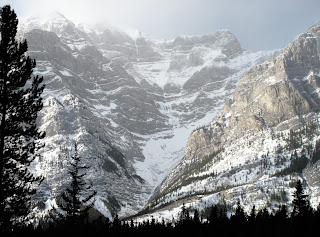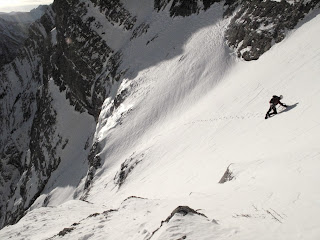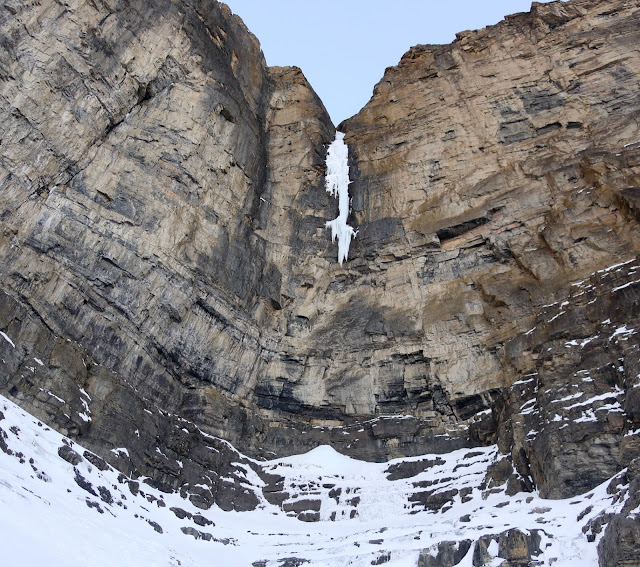Bigg Kidd
The relentless beep-beep-beep of the alarm wormed its way
into my dreams. Surely it was still too early to rise and get ready for my
morning class, wasn’t it? Slowly, reluctantly, I emerged from the depths of
sleep and remembered the backpack full of gear sitting by the front door, the water
bottles lined up on the kitchen counter. It was indeed far too early to get up
for work, but not too early to rise if we wanted to hit the snow-covered trail below
Mt. Kidd by headlamp.
It’d been a busy yet lazy fall. Classes and committees at
the university seemed to claim more than their usual share of my time, while
evenings and weekends were spent writing about last summer’s expedition to
Pakistan. I had an uneasy feeling that I was contemplating life instead of living
it. The odd thing was, it was largely by choice. When Greg and Nick, visiting
from the UK, suggested I join them at the Stanley Headwall, I replied I’d rather
sleep in and write, maybe go drytooling for a few hours in the afternoon. I just
couldn’t bring myself to get up in the dark, drive out in the dark and, still
in the dark, trudge up a trail every dip and turn of which I knew by heart. Was
I burning out? Or did I just need the right kind of persuasion?
Another trail I knew well led up Evan-Thomas Creek. The hundred-metre
tall Moonlight had been my first multi-pitch ice climb. And it lived up to its
name, as we topped out in the dark. Since that day I’d returned many times to the
parallel flows pouring down rock that was shattered and rank even by Rockies’
standards. Sadly, none of those times rivaled the intensity of the first one.
But I digress. On the walk out, with the last flat stretch of trail dragging on
as usual, my eyes would be drawn to the bulk of Mt. Kidd across the valley. The
icy haze of a fading winter’s day blurred the sharp edges of the peak, but the exclamation
mark of ice on the highest rock band was unmistakable. Then I would arrive at
the trailhead, and that distant white ribbon would be forgotten in the warmth
of a fogged up car. Until, casting about for motivation, I remembered it last
fall.
My toes tingled inside lightweight boots as Steve and I
slogged through depth hoar at the base of the big northeast bowl on Mt. Kidd. The
frosty air of early morning seeped through layers of clothing like cold water.
But the rising sun was already painting the highest cliffs a warm yellow, and
it wasn’t long before the fresh snow around us sparkled in the bright light,
making me wish I’d brought sunglasses.
The first avalanche rumbled down while we were gearing up.
We rationalized the powder slough away: “It’s just the morning sun hitting the
rock. The face will go into shade soon.” And we set off scrambling up snow
gullies and ice steps. Pulling over a bulge, I looked up to see a white cloud
charging down. “Avalanche!” I shouted to Steve ten metres lower, and sprinted for
the nearest rock band. Fortunately the trainload of snow rumbled down the gully
next to us, but it’d made its point. Thirty seconds later we were swinging and
kicking down as fast as we could. It was only noon when I drove back to the
city across the bare prairies, grasses waving in the wind like a yellow sea.
Two weeks I was back on Mt. Kidd. At the base of the
northeast bowl, where Steve and I’d stumbled over snow-covered scree, Ian and I
cramponed up massive piles of avalanche debris. It was hard to believe it was still
November. A few hundred metres higher, I stood on a steeply tilted snow ledge
and waited while Ian soloed a narrow ribbon of ice. Every few moves he’d stop
and wait, hooded head down, while spindrift washed over him. Then “You’re good
to go!” he shouted as he stepped off the ice and disappeared from view over the
lip. I knew snow stability was good but still felt relieved to move out of the
gully onto a rib of windswept scree. Twenty minutes later we dropped our packs
under the overhanging rock of the highest rock band and got to work.
A climbing partner once referred to new routes you don’t
just walk up to and send as science projects. Considering the short days of
late November, a location a thousand metres above the valley floor and much
blank rock separating us from the ice of our desire, I knew the Mt. Kidd route
would fall into this category. So I wasn’t surprised to be making plans for a
return visit as we drove away that evening. A few days later we were back. By
mid-afternoon, after much scratching around, a couple of broken holds and as
many spectacular falls, we swung our tools at the desiccated fringe of ice at
the bottom of the white ribbon. Two pitches higher daylight was fading as I
pulled over a bulge and gazed up into the snow bowl feeding the route. Far
below car headlights crept along the highway on the valley floor. Yet even as
we drilled the first v-thread, I felt an irrational urge to head up instead of
down, to the darkening summit ridge a hundred metres higher. Maybe I wasn’t
burnt out after all.
Summary: First ascent of Bigg Kidd (150 m, WI5 M7+), Raphael Slawinski and Ian Welsted, November 27 and 30, 2013.
Summary: First ascent of Bigg Kidd (150 m, WI5 M7+), Raphael Slawinski and Ian Welsted, November 27 and 30, 2013.
The big bowl on Mt. Kidd: a cool if somewhat spooky place. Bigg Kidd tackles the obvious discontinuous ribbon through the highest rock band.
The low November sun barely cleared the summit of The Wedge as Steve Swenson slogged up through fresh snow into the northeast bowl of Mt. Kidd.
Snow, wind and sun make for a bad combination. After a couple of heavy sloughs rumbled past us, Steve and I decided getting the chop on humble Mt. Kidd would be embarrassing for a couple of alpine veterans. We quickly downclimbed while keeping a wary eye out in case anything else came down, and ran away toward the safety of the trees on the valley bottom.
An avalanche cycle later, Ian Welsted was able to enjoy fast and safe travel up snow slopes pounded by massive slides. It's all timing and hormones, as Choc Quinn once quipped.
After all the early - and sometimes false - starts, I was psyched to round a rib of windswept scree, and finally see the object of our desire just a couple hundred metres away.
The ice on the first pitch gonged ominously, while screws either hit rock or spun into air. But in the proud tradition of Cesare Maestri we'd carried our courage in our rucksacks, and so were spared the cold need for boldness - but also denied the warm rewards of it.
With the belay tucked in under a bulge, the mixed business was hidden from the eye and camera of the belayer. But as is usually the case with unformed icicles, while the drytooling might have been harder, the dry, brittle ice above the rock was the real reason for coming this far. Photo: Ian Welsted.
Another morning, another sunrise over The Wedge from high on Mt. Kidd.











Amazing adventure! 😄
ReplyDelete